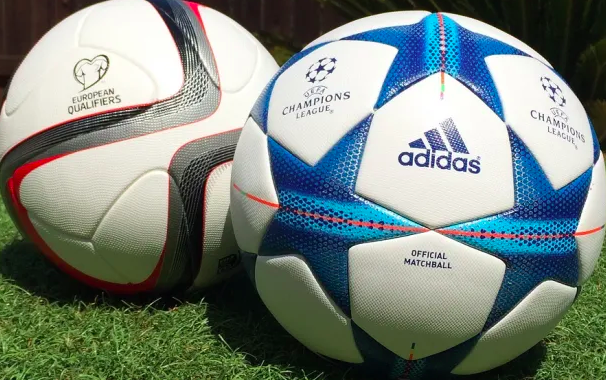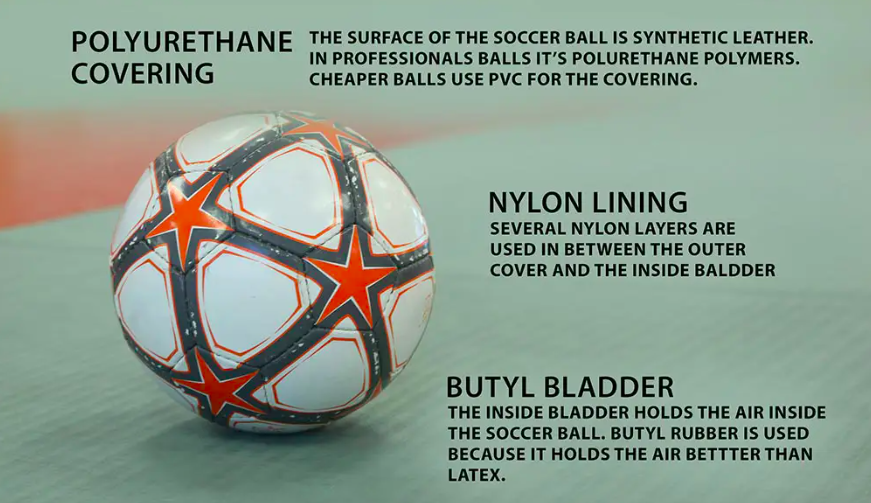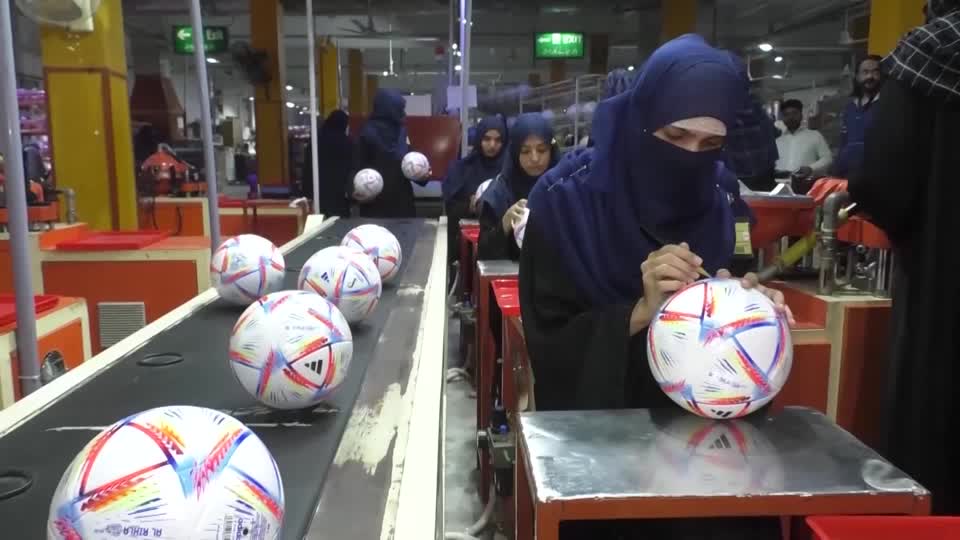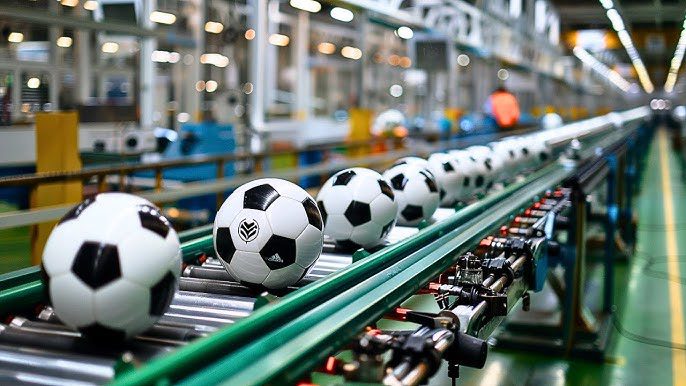How Is A Soccer Ball Made? Complete Guide (2025)
Have you ever wondered how is a soccer ball is made – this is for you.
This is a question that comes to the mind of many soccer fans, but not everyone knows the answer and the complete process of how soccer balls are made.
Soccer balls are made up of several layers of materials, and the manufacturing process is a bit more complicated than you might think.
In this post, we will take a closer look at how a soccer ball is made step by step, so that you can gain a better understanding of what goes into creating this essential piece of equipment.

How Is A Soccer Ball Made?
A soccer ball is made up of several layers of materials, including synthetic leather, latex or butyl bladder, and graphics.
The manufacturing process is complex and involves cutting the panels, sewing them together, adding the bladder, and adding the graphics.
The end product is then subjected to quality control to ensure that it meets the required standards.
Let’s dive into the exact process used to create soccer balls in the modern game.

How Is A Soccer Ball Made Step By Step
Step 1: Cutting the Panels
The first step in making a soccer ball is to cut the panels that will be used to make the ball.
The panels are usually made of synthetic leather, which is a durable and water-resistant material. The panels are cut into shapes that are then sewn together to form the ball.
Step 2: Sewing the Panels Together
Once the panels have been cut, they are sewn together using a special machine. The machine sews the panels together using a double-stitch, which helps to create a strong and durable seam.
This is an important step in the manufacturing process, as the ball needs to be able to withstand the intense pressure and impact of a soccer game.
Step 3: Adding the Bladder
After the panels have been sewn together, the next step is to add the bladder. The bladder is the inner part of the ball that holds the air.
It is usually made of latex or butyl and is inserted into the ball through a small hole. Once the bladder is in place, the hole is sealed to prevent air from escaping.
Step 4: Adding the Graphics
Once the ball has been assembled and the bladder is in place, the next step is to add the graphics. The graphics are usually printed onto the ball using a special screen printing process.
The graphics can include the team logo, the manufacturer’s logo, and any other designs or patterns that the ball may have.
Step 5: Quality Control
The final step in the manufacturing process is quality control. Each ball is inspected to ensure that it meets the required standards for size, weight, and shape.
If any defects are found, the ball is discarded and a new one is made in its place.

How Are Soccer Balls Manufactured
In today’s video, we’ll be talking about how a soccer ball is made and what materials are used to make it. As soccer players, we use a soccer ball on the field every time we play, but have you ever wondered how this amazing piece of equipment is made?
Well, wonder no more because in this video, we’ll be taking a deep dive into the manufacturing process of a soccer ball and the materials used to make it.
Watch this video and learn about the fascinating world of soccer ball production!
How Is A Soccer Ball Made Video
In conclusion, a soccer ball is made up of several layers of materials, including synthetic leather, latex or butyl bladder, and graphics.
Now that you know how a soccer ball is made, you can appreciate the amount of work that goes into creating this essential piece of equipment for every soccer player.
Common Questions
Here are some commonly asked questions on the topic of how is a soccer ball made:
What Is the Process to Make a Soccer Ball?
The process of making a soccer ball involves several detailed steps:
- Material Preparation: Panels are cut from synthetic leather or similar materials. The bladder (inner air-filled chamber) is prepared separately, usually from latex or butyl.
- Panel Shaping: The panels, often hexagonal and pentagonal, are precisely cut for consistency and then prepared for stitching or gluing.
- Assembly: Panels are either sewn together by hand, machine, or thermo-bonded using heat. Hand stitching is common for higher-quality balls.
- Bladder Insertion: The inner bladder is inserted through an opening in the stitched panels.
- Graphics and Coating: The outer surface is printed with designs, logos, or graphics and coated for durability and water resistance.
- Quality Testing: The ball undergoes strict testing for shape, bounce, water resistance, and durability to meet international standards.
What Material Can a Soccer Ball Be Made From?
Modern soccer balls are typically made of:
- Outer Surface: Polyurethane (PU) for premium balls or polyvinyl chloride (PVC) for lower-cost options.
- Lining: Cotton or polyester layers to provide shape retention and added strength.
- Bladder: Latex or butyl, depending on whether softer touch (latex) or better air retention (butyl) is prioritized.
In earlier times, leather was used, but it absorbed water, making the ball heavier, so synthetic materials are now preferred.
What Makes a Soccer Ball a Soccer Ball?
Several key elements distinguish a soccer ball:
- Shape: A near-perfect sphere for consistent rolling and flight.
- Panels: Typically 32 panels (20 hexagons and 12 pentagons) on traditional balls, though modern designs often vary.
- Durability: Made from tough, water-resistant materials to withstand kicks and weather conditions.
- Standards: It adheres to precise weight, size, and bounce requirements, especially in professional play, to ensure fair competition.
What Are the Ingredients in a Soccer Ball?
The “ingredients” of a soccer ball refer to the materials used:
- Outer Layer: Polyurethane (PU) or PVC for the synthetic leather coating.
- Inner Lining: Cotton or polyester layers for durability and structure.
- Bladder: Latex or butyl to hold air.
- Adhesives: For panels that are glued rather than stitched.
- Printing Ink and Coating: For graphics and a protective finish.
High-quality soccer balls may also include thermoplastic polyurethane (TPU) coatings for a premium touch and additional layers for better performance under high-impact play.

SOCCER PLAYERS
Want to become a better soccer player?
Watch this 3-minute video about discovering your true potential
Learn how to improve your skills, mindset, soccer IQ, and fitness—no matter your level. Start playing with confidence, earning respect, and impressing coaches today.
About Coach Dylan
I used to struggle with confidence in soccer, feeling slow, weak, and unmotivated. Coaches overlooked me, and friends made fun of my skills. At one point, I even quit.
But I decided to take control of my development. Through hard work, I transformed my game, earned league titles, awards, a college scholarship, and international caps.
Now, I share my lessons and help others improve through my YouTube channel (1/2 million subscribers), soccer coaching and personal training.

How To Play Soccer Better
Struggling to make progress in soccer or stay organized with your training?
The Soccer Success Planner will help you stay focused, motivated, and increase your chances of achieving your goals in soccer.
Success doesn’t happen accidentally. Use it to set clear goals, create a plan of action, and take control of your future. Learn more about the Soccer Success Planner.
How To Become A Better Soccer Player
Struggling to improve in soccer or unsure how to train effectively? Want to stand out and earn respect from teammates and coaches?
The Online Soccer Academy will get you better results in less time.
Thousands of players have already transformed their game in just 60 days. Learn more about how the online soccer academy.

Related Posts
Here are some related posts to help you gain more knowledge and helpful advice:
Best Ways To Train For Soccer At Home
How To Be A Great Midfielder In Soccer
Coach Dylan
Progressive Soccer
Thank you for reading this article:
How Is A Soccer Ball Made? Complete Guide (2025)
